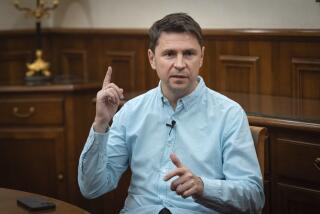Kampelman Sees Hope for Strategic Arms Accord by Year’s End
- Share via
WASHINGTON — U.S. and Soviet negotiators could go far beyond an expected ban on intermediate-range missiles and agree to cut in half the arsenals of long-range strategic nuclear weapons before the end of this year, the chief U.S. delegate to the Geneva arms control talks said Thursday.
“We want the strategic 50% reductions . . . also to be decided and agreed upon during the Reagan Administration,” Ambassador Max M. Kampelman said. “We could do it by the end of the year, in my opinion.”
Although Kampelman hedged his prediction by saying that an agreement could be reached only if the Soviets assign more negotiators to the talks to permit an increased pace of bargaining, his comments were by far the most optimistic from a senior Administration official concerning the deadlocked Strategic Arms Reduction Talks.
“We’re close enough now that if the Soviets will join us in the effort, and that means beefing up their team (in Geneva) as well . . . we can get that (an agreement on intercontinental missiles) done by the end of the year,” Kampelman said in an interview with broadcaster John McLaughlin taped Thursday to be aired Sunday on his “One on One” program.
The U.S. ambassador sought to revive public interest in the strategic arms negotiations one day after West German Chancellor Helmut Kohl removed a major obstacle to an intermediate nuclear forces agreement by offering to eliminate Bonn’s 72 aging Pershing 1-A missiles once the United States and the Soviet Union implement an agreement banning all other intermediate weapons.
Kampelman said there is no formal linkage between the INF and START proposals. He said INF could stand on its own, although the Administration believes that it would be better to follow it with a strategic weapons agreement.
A Soviet spokesman praised Kohl’s action Thursday, joining President Reagan in endorsing the plan. That apparently seals the compromise and clears the way for completion of the intermediate-range missile talks, possibly before Secretary of State George P. Shultz and Soviet Foreign Minister Eduard A. Shevardnadze meet in Washington on Sept. 15 in a session that could lay the groundwork for a U.S.-Soviet summit conference.
Ever since they resumed in 1985, U.S.-Soviet arms control talks have been broken into three parts: INF, which covers ground-based missiles with ranges of 300 to 3,000 miles; START, which covers land-based weapons with ranges of more than 3,000 miles plus long-range submarine-based missiles, and space and defensive weapons, which covers anti-missile technology like the U.S. Strategic Defense Initiative, or “Star Wars” program.
The Soviets have demanded an end to SDI to achieve a space weapons pact. The United States has adamantly refused to take that step. And Moscow has said that it would not agree to a START treaty unless a space weapons agreement had already been reached. For Kampelman’s prediction of an agreement on long-range weapons to materialize this year, either the United States or the Soviet Union would have to yield on the “Star Wars” issue.
Meanwhile, a new controversy is brewing over measures to prevent cheating on the proposed INF pact. The United States revised its proposals for verification this week, a step that the Administration described as a “simplification” of the procedures but that some conservatives denounced as a softening of Washington’s long-stated objective of devising foolproof ways of preventing Soviet violations.
James T. Hackett, a former Arms Control and Disarmament Agency official now on the staff of the conservative Heritage Foundation, said that the proposed INF treaty is virtually unverifiable even under the more stringent measures the United States first suggested.
“What you have is an agreement that is based on trust of the Soviets,” he said in a telephone interview. “Given their arms control record, that doesn’t make much sense.”
“It looks as though, if the Administration wants an agreement, they can probably get one this fall,” he said. “Whether the Senate will ratify it is another question . . . “
Some arms control advocates agree that there is no iron-clad way to prevent all violations, but they say that such certainty is not necessary.
Plans Called Adequate
Jack Mendelsohn, a former U.S. arms control negotiator now on the staff of the private Arms Control Assn., said that the Administration’s revised verification plans are adequate to prevent any militarily significant cheating.
Moreover, he said, the on-site inspections originally proposed by the Administration would have been reciprocal and, therefore, would have allowed Soviet inspectors to observe sensitive U.S. and allied facilities.
“They (Administration officials) painted themselves into a corner over what they said they wanted in an agreement,” Mendelsohn said in a telephone interview. “The Soviets called our bluff. Some of the things we were talking about were either nonsense or dangerous or both. The treaty is not more or less verifiable than it was in the past.”
In another development, a spokesman for the U.S. Arms Control and Disarmament Agency said that four U.S. military inspectors will carry out an on-site inspection today of Soviet maneuvers near Minsk in a confidence-building gesture arranged by the two superpowers, the Associated Press reported Thursday night.
It is the first such U.S. inspection of Soviet military maneuvers under a broad, 35-nation Stockholm agreement reached in September, 1986, that seeks to lessen tensions between East and West.
More to Read
Sign up for Essential California
The most important California stories and recommendations in your inbox every morning.
You may occasionally receive promotional content from the Los Angeles Times.










